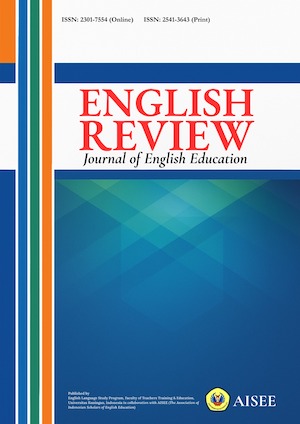PRAGMATIC TRANSFER IN APOLOGY EMPLOYED BY ENGLISH EDUCATION STUDENTS OF ISLAMIC STATE UNIVERSITY (UIN) RADEN FATAH
Abstract
This study intends to find out and to describe apology strategies made by the sixth and eighth semester students of English Education Study Program of Islamic State University (UIN) Raden Fatah Palembang, and to explain how the pragmatic transfer interferes the apology strategies. This study used a qualitative descriptive design. Written discourse completion tasks and observation by doing a role play were used as the instruments to obtain the data. There were 66 students selected as the subjects of study. The data obtained were analyzed based on the classification of apology strategy proposed by Olshtain and Cohen (1983). As result, it was found that there were five apology strategies made by the students, for example, using the word sorry to express regret was considered the most frequently used strategy. Then, the result also showed that the speakers who have low social status tend to use polite strategy in all levels of social relationships (strangers and acquaintances). For the speakers who have high social status and equal tend to use less polite and casual expressions, respectively. Moreover, some students use some pragmatic transfers in expressing apology strategies influenced by their L1 (mother tongue) or L2 (Indonesian) culture.References
Brown, P., & Levinson. (1987). Some universals in language usage. Cambridge, UK: Cambridge University Press.
Bu, J. (2012). A study of relationships between L1 pragmatic transfer and L2 proficiency. English Language Teaching, 5(1), 32-43. doi: 10.5539/elt.v5n1p32.
Cohen, A. D., & Olshtain, E. (1993). The production of speech acts by EFL learners. TESOL Quarterly. 27(1), 33-56. doi: 10.1177/026553228500200103.
Ellis, R. (2012). The study of second language acquisition. USA: Oxford University Press.
Gass, S. M., & Slinker, L. (2001). Second language acquisition an introductionary course. Marwah, NJ: Lawrence Erlbaum Associates Publisher.
Goffman, E. (1971). Relations in public: Microstudies of the public order. New York, NY: Basic Books.
Holmes, J. (1989). Sex differences and apologies: One aspect of communicative competence. Applied Linguistics, 10(2), 194-213.
Istifci, I. (2009). The use of apologies by EFL learners. Journal of English Language Teaching, 2(3), 15-25.
Jebahi, K. (2011). Tunisian university students choice of apology strategies in a discourse completion task. Journal of Pragmatics, 43(2), 648-662. doi: 10.1016/j.pragma.2010.09.008.
Kasper, G. (1992). Pragmatic transfer. Second Language Research, 8(3), 203-231. doi: 10.1177/026765839200800303.
Moghaddam, M. M. (2012). Discourse structures of condolence speech act. Journal of English Language Teaching and Learning. 1(10), 106-125.
Olshtain, E., & Cohen, A. D. (1983). Apology: A speech act set. Sociolinguistics and Language Acquisition, 5(20), 18-35.
Qorina, D. (2012). Realization of apology strategies by English department students of Pekalongan University. Journal of Language and Literature, 7(1), 93-105.
Sugimoto, N. (1998). Norms of apology depicted in US American and Japanese literature on manners and etiquette. International Journal of Intercultural Relations, 22(3), 251-276.
Syahri, I. (2013). Resemblance of indirectness in politeness of EFL learners request. Indonesian Journal of Applied Linguistics, 3(1), 148-165.
Syahri, I., & Kadarisman, A. E. (2007). Pragmatic transfer in request realization. TEFLIN Journal, 18(2), 123-147.
Tamimi Sad, S. H., & Mohammadi, M. (2014). A cross-sectional study of Iranian EFL learners' polite and impolite apologies. Journal of Language and Linguistic Studies, 10(1), 119-136.
Tuncel, R. (2011). Apologizing and speech act realizations of Turkish EFL learners. Paper presented at International Conference on Management, Economics and Social Sciences (ICMESS) Bangkok. Retrieved from http://psrcentre.org/images/extraimages/1211799.pdf.
Wouk, F. (2006). The language of apologizing in Lombok, Indonesia. Journal of Pragmatics, 38(6), 1457-1486. doi: 10.1016/j.pragma.2005.09.011.
All articles published in English Review: Journal of English Education (ERJEE) are licensed under the Creative Commons Attribution 4.0 International License (CC BY 4.0).
Copyright Ownership
Authors retain the copyright of their articles and grant ERJEE the right of first publication. The journal is granted a non-exclusive license to publish, reproduce, and distribute the article in any format, medium, or platform, provided that proper credit is given to the original authors.
License Terms – CC BY 4.0
Under the Creative Commons Attribution 4.0 International License, others are free to:
- Share — copy and redistribute the material in any medium or format
- Adapt — remix, transform, and build upon the material for any purpose, even commercially
As long as they:
- Provide appropriate credit to the original author(s) and source
- Provide a link to the license (https://creativecommons.org/licenses/by/4.0/)
- Indicate if any changes were made
There are no restrictions on the reuse, reproduction, or adaptation of published articles as long as attribution is properly given.
Author Warranties
By submitting a manuscript to ERJEE, authors confirm that:
- The work is original and does not infringe any existing copyright.
- The manuscript has not been previously published and is not under consideration elsewhere.
- All sources and references are appropriately acknowledged.
- Necessary permissions have been obtained for any copyrighted materials used.









